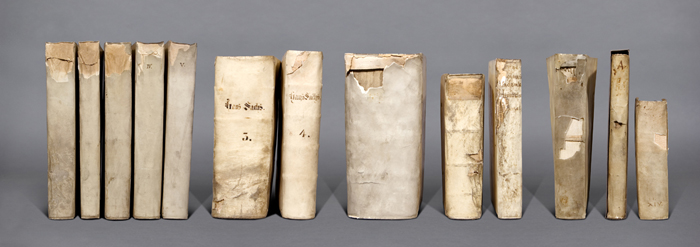Book conservation - current project
|
|
Materials and Methods for Filling Losses in Parchment Bound Volumes
In collaboration with the Institute for Conservation of the Austrian National Library and as a part of a diploma thesis at the Academy of Fine Arts Vienna a number of experiments were performed in order to assess and compare properties of infill materials such as hygrostability and optical qualities, considering the specific requirements of books in use.
Typical damage on parchment bindings Parchment was traditionally used for simple bindings. It was cheaper than leather and at the same time a durable material. Though Parchment is a robust material, poor storage conditions like sunlight or climatic fluctuations can lead to irreversible changes within the parchment structure. The material becomes fragile and brittle leading to tears and losses. Losses in the spine of parchment bound volumes are usually located at the most vulnerable areas: head and tail, as well as next to the cords.Fehlstellen am Buchrücken kommen vor allem an den besonders beanspruchten Bereichen des Rückens wie dem Kopf- und Fußbereich sowie über den Bünden vor.
Infills: technique and material Losses are commonly filled with inlays of different materials and in various techniques. Depending on the damage, the inlays are made with a little overlap from edge to edge. The most common materials for infills are Japanese paper in several layers and parchment. Another possible material is reconstituted parchment. Reconstituted parchment is made of a suspension of paper pulp and parchment powder.
Material properties and decisions Though Japanese paper and parchment react different to climate changes, Japanese paper is the better choice, for avoiding tensions within the infill. It is also easier to apply. Because parchment is a natural material showing variations in strength and tension, it is a risk to use it for mending of damaged parchment. Laminating the new parchment with paper can reduce this risk. The advantage of using parchment and reconstituted parchment lies in the aesthetical integration. Moreover the „reconstituted parchment“ can be modified in thickness and colour and hence adapted to the individual damage. Similar to parchment „reconstituted parchment“ is sensitive to moisture, showing shrinkage and causing tensions unless it is laminated. Making decisions in favour or against a material will always depend on the damage, storage conditions and material properties.
Different materials after humidification |



.jpg)